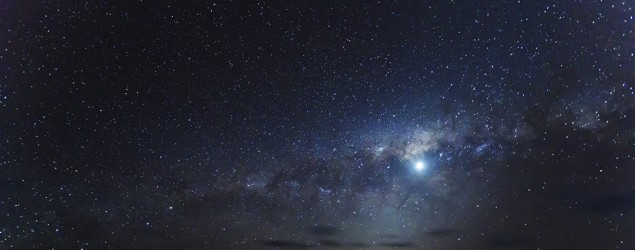 Washington, Oct 16 (IANS) Astronomers have discovered that our nearest galactic neighbours, the spheroidal dwarf galaxies, are devoid of star-forming gas and the Milky Way Galaxy is to blame for it.
Using the US National Science Foundation's Green Bank Telescope (GBT) in West Virginia, along with data from other large radio telescopes, new observations reveal that within a well-defined boundary around our galaxy, dwarf galaxies are completely devoid of hydrogen gas.
Beyond this point, dwarf galaxies are teeming with star-forming material.
"Astronomers wondered if, after billions of years of interaction, the nearby dwarf spheroidal galaxies have all the same star-forming 'stuff' that we find in more distant dwarf galaxies," said astronomer Kristine Spekkens, assistant professor at the Royal Military College of Canada.
Spekkens and her team probed the dwarf galaxies that have been swarming around the Milky Way for billions of years for tiny amounts of atomic hydrogen.
"What we found is that there is a clear break, a point near our home galaxy where dwarf galaxies are completely devoid of any traces of neutral atomic hydrogen," Spekkens said.
Beyond this point, which extends approximately 1,000 light-years from the edge of the Milky Way's star-filled disk to a point that is thought to coincide with the edge of its dark matter distribution, dwarf spheroidals become vanishingly rare while their gas-rich counterparts flourish.
"The Milky Way thus shuts down star formation in its smallest neighbours," the astronomers added.
The Milky Way galaxy is the largest member of a compact clutch of galaxies that are bound together by gravity.
Swarming around our home galaxy is a menagerie of smaller dwarf galaxies, the smallest of which are the relatively nearby dwarf spheroidals, which may be the leftover building blocks of galaxy formation.
The paper appeared in the Astrophysical Journal Letters.
Washington, Oct 16 (IANS) Astronomers have discovered that our nearest galactic neighbours, the spheroidal dwarf galaxies, are devoid of star-forming gas and the Milky Way Galaxy is to blame for it.
Using the US National Science Foundation's Green Bank Telescope (GBT) in West Virginia, along with data from other large radio telescopes, new observations reveal that within a well-defined boundary around our galaxy, dwarf galaxies are completely devoid of hydrogen gas.
Beyond this point, dwarf galaxies are teeming with star-forming material.
"Astronomers wondered if, after billions of years of interaction, the nearby dwarf spheroidal galaxies have all the same star-forming 'stuff' that we find in more distant dwarf galaxies," said astronomer Kristine Spekkens, assistant professor at the Royal Military College of Canada.
Spekkens and her team probed the dwarf galaxies that have been swarming around the Milky Way for billions of years for tiny amounts of atomic hydrogen.
"What we found is that there is a clear break, a point near our home galaxy where dwarf galaxies are completely devoid of any traces of neutral atomic hydrogen," Spekkens said.
Beyond this point, which extends approximately 1,000 light-years from the edge of the Milky Way's star-filled disk to a point that is thought to coincide with the edge of its dark matter distribution, dwarf spheroidals become vanishingly rare while their gas-rich counterparts flourish.
"The Milky Way thus shuts down star formation in its smallest neighbours," the astronomers added.
The Milky Way galaxy is the largest member of a compact clutch of galaxies that are bound together by gravity.
Swarming around our home galaxy is a menagerie of smaller dwarf galaxies, the smallest of which are the relatively nearby dwarf spheroidals, which may be the leftover building blocks of galaxy formation.
The paper appeared in the Astrophysical Journal Letters.


No comments:
Post a Comment